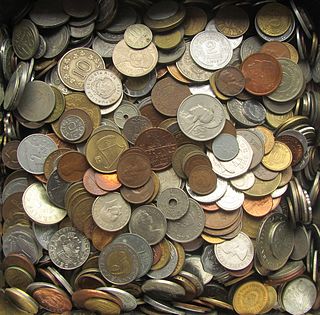
A coin is a small object, usually round and flat, used primarily as a medium of exchange or legal tender. They are standardized in weight, and produced in large quantities at a mint in order to facilitate trade. They are most often issued by a government. Coins often have images, numerals, or text on them. The faces of coins or medals are sometimes called the obverse and the reverse, referring to the front and back sides, respectively. The obverse of a coin is commonly called heads, because it often depicts the head of a prominent person, and the reverse is known as tails.
Byzantine currency, money used in the Eastern Roman Empire after the fall of the West, consisted of mainly two types of coins: gold solidi and hyperpyra and a variety of clearly valued bronze coins. By the 15th century, the currency was issued only in debased silver stavrata and minor copper coins with no gold issue. The Byzantine Empire established and operated several mints throughout its history. Aside from the main metropolitan mint in the capital, Constantinople, a varying number of provincial mints were also established in other urban centres, especially during the 6th century.
Roman Republican currency is the coinage struck by the various magistrates of the Roman Republic, to be used as legal tender. In modern times, the abbreviation RRC, "Roman Republican Coinage" originally the name of a reference work on the topic by Michael H. Crawford, has come to be used as an identifying tag for coins assigned a number in that work, such as RRC 367.

The ducat coin was used as a trade coin in Europe from the later Middle Ages to the 19th century. Its most familiar version, the gold ducat or sequin containing around 3.5 grams of 98.6% fine gold, originated in Venice in 1284 and gained wide international acceptance over the centuries. Similarly named silver ducatons also existed. The gold ducat circulated along with the Florentine florin and preceded the modern British pound sterling.
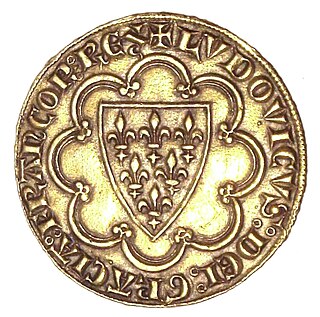
The term écu may refer to one of several French coins. The first écu was a gold coin minted during the reign of Louis IX of France, in 1266. The value of the écu varied considerably over time, and silver coins were also introduced.
The Venetian grosso is a silver coin first introduced in Venice in 1193 under doge Enrico Dandolo. It originally weighed 2.18 grams, was composed of 98.5% pure silver, and was valued at 26 denarii. Its name is from the same root as groschen and the English groat, all deriving ultimately from the denaro grosso.

Like the Egyptians, Phoenicians and Carthaginians, the Etruscans were rather slow to adopt the invention of coinage. The brief period of Etruscan coinage, with the predominance of marks of value, seems to be an amalgam that reconciles two very different monetary systems: the 'primitive' bronze-weighing and aes grave economy of central Italy with that of struck silver and gold issues of southern Italian Greek type not familiar in Etruria.
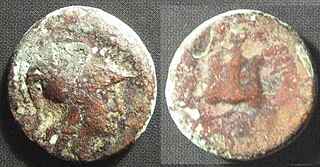
The Coinage of Side refers to numismatic objects produced at Side, an ancient Greek colony in modern-day Pamphylia, Turkey.
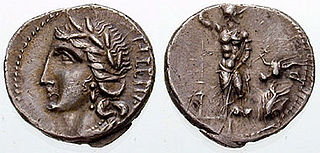
The family of Social War coinage includes all the coins issued by the Italic allies of the Marsic confederation, Marsi, Peligni, Piceni, Vestini, Samnites, Frentani, Marrucini, and Lucani, during the Social War against Rome.
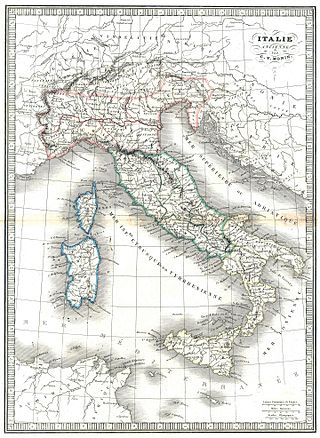
Italy has a long history of different coinage types, which spans thousands of years. Italy has been influential at a coinage point of view: the medieval Florentine florin, one of the most used coinage types in European history and one of the most important coins in Western history, was struck in Florence in the 13th century, while the Venetian sequin, minted from 1284 to 1797, was the most prestigious gold coin in circulation in the commercial centers of the Mediterranean Sea.

The Coinage of the Republic of Venice include the coins produced by the Republic of Venice from the late 12th century to 1866. After this date, coins were still produced in Venice.
Carthaginian or Punic currency refers to the coins of ancient Carthage, a Phoenician city-state located near present-day Tunis, Tunisia. Between the late fifth century BC and its destruction in 146 BC, Carthage produced a wide range of coinage in gold, electrum, silver, billon, and bronze. The base denomination was the shekel, probably pronounced in Punic. Only a minority of Carthaginian coinage was produced or used in North Africa. Instead, the majority derive from Carthage's holdings in Sardinia and western Sicily.
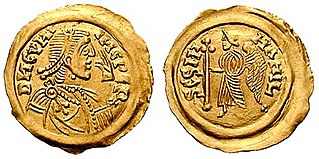
The coinage of the Lombards refers to the autonomous productions of coins by the Lombards. It constitutes part of the coinage produced by Germanic peoples occupying the former territory of the Roman Empire during the Migration Period. All known Lombard coinage was produced after their settlement of Italy. The coinage originates from two distinct areas, in Langobardia Major between the last decades of the sixth century and 774, and in Langobardia Minor, in the duchy of Benevento, between approximately 680 and the end of the 9th century.

The Agontano was the currency used by the Italian Maritime Republic of Ancona from the 12th to the 16th centuries during its golden age. It was a large silver coin of 18-22mm in diameter and a weight of 2.04-2.42 grams, of roughly equivalent value to the Milanese Soldo.
The coinage of Suessa concerns coins minted in Suessa, a city in ancient Campania inhabited by the Aurunci, an ancient Italic population. The city minted coins in the period between 268 B.C. and the Second Punic War.

The coinage of Capua concerns coins minted in ancient Capua, a city in ancient Campania, corresponding to present-day Santa Maria Capua Vetere. The city was located on the Appian Way and was the most important in the area, probably the largest center in the Italian peninsula after Rome.

The coinage of Cales concerns coins minted in Cales, a city in Campania, the most important urban center of the ancient Italic population of the Ausones. Cales was located on the Via Latina, halfway between the mountains of Samnium and the plains of Campania felix, a few kilometers north of Casilinum and just south of Teanum Sidicinum.

The Lombard coinage of Benevento, part of the more general Lombard coinage, is the set of coins minted between about 680 and the end of the ninth century in the duchy and principality of Benevento. Solidi and tremisses, both gold coins that imitated those of the Eastern Roman Empire, were first minted; later followed the issuance of coins in the names first of the dukes and then of the Benevento princes. Toward the end of the 8th century alongside the gold coins were minted silver coins, which gradually took the place of the earlier ones, as moreover happened in the rest of Western Europe. Silver became the prevalent coinage metal only from the mid-9th century.

Coinage of Aesernia concerns coins minted in Aesernia, a city in Samnium, where a Roman colony was created in 263 BC. The coins were minted around 263 to 240 B.C., after the colony was founded.
Coinage of Luceria concerns the coins issued in Luceria, a city in Daunia, after the Romans established a colony.
























